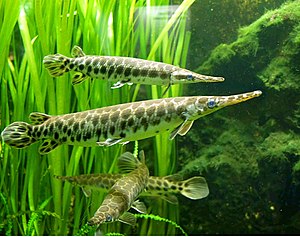Ginglymodes
| Ginglymodes | ||||||||||||
|---|---|---|---|---|---|---|---|---|---|---|---|---|

Spotted fish ( Lepisosteus oculatus ) in an aquarium of the Aquazoo in Düsseldorf. |
||||||||||||
| Temporal occurrence | ||||||||||||
| Anisium (Middle Triassic) until today | ||||||||||||
| 247.2 to 0 million years | ||||||||||||
| Locations | ||||||||||||
|
||||||||||||
| Systematics | ||||||||||||
|
||||||||||||
| Scientific name | ||||||||||||
| Ginglymodes | ||||||||||||
| Cope , 1872 |
The Ginglymodi are a taxon (a systematic group) of primeval bony fish that has been recorded in fossil records since the Middle Triassic and has survived to this day with the seven species of bake . Ginglymodes include all taxa that are more closely related to Lepisosteus than to Dapedium , Amia or Pholidophorus .
features
The Ginglymodi are neopterygii (Neopterygii), among others, by the following characteristic features diagnosed are:
The exoccipital, a bone at the base of the skull, expands anteriorly and encloses the vagus nerve . The premaxillary has a nasal outgrowth. The subopercular is well developed and has a tapered dorsal outgrowth. The width of the suboperculare is less than half the width of the operculare (both bones of the gill cover ). A bony throat plate (gulare) between the two branches of the lower jaw is missing. The quadratojugale is rail-like. The nasal ( nose bone ) is long and narrow. The eyes are enclosed by a closed ring made of small bones (circumorbital ring). The supraorbitalia (circumorbital bones dorsal to the eye) are large. Numerous supraorbital bones stand in a row and reach in front of the orbit . The supracleithrum, a cover bone of the shoulder girdle, articulates with the posterior bone (post-temporal) via a concave joint surface. A number of teeth lie on the ridge between the gills and the side surfaces of the cleithrum . On the upper edge of the caudal fin there is a scale-like fin ray .
Systematics

The Ginglymodi consist of two main clades, the bonefish-like (Lepisosteiformes) and the extinct Semionotiformes . There are also two extinct genera that cannot be assigned to either of the two clades ( incertae sedis ), Neosemionotus and Kyphosichthys .
| Ginglymodes |
|
||||||||||||||||||||||||||||||||||||||||||||||||
|
|
literature
- Adriana López-Arbarello: Phylogenetic Interrelationships of Ginglymodian Fishes (Actinopterygii: Neopterygii). PLoS ONE , doi : 10.1371 / journal.pone.0039370
Individual evidence
- ↑ GuangHui Xu, FeiXiang Wu: A deep-bodied ginglymodian fish from the Middle Triassic of eastern Yunnan Province, China, and the phylogeny of lower neopterygians. In: Chinese Science Bulletin. Vol. 57, No. 1, January 2012, ISSN 0250-7862 , pp. 111-118, doi : 10.1007 / s11434-011-4719-1 .